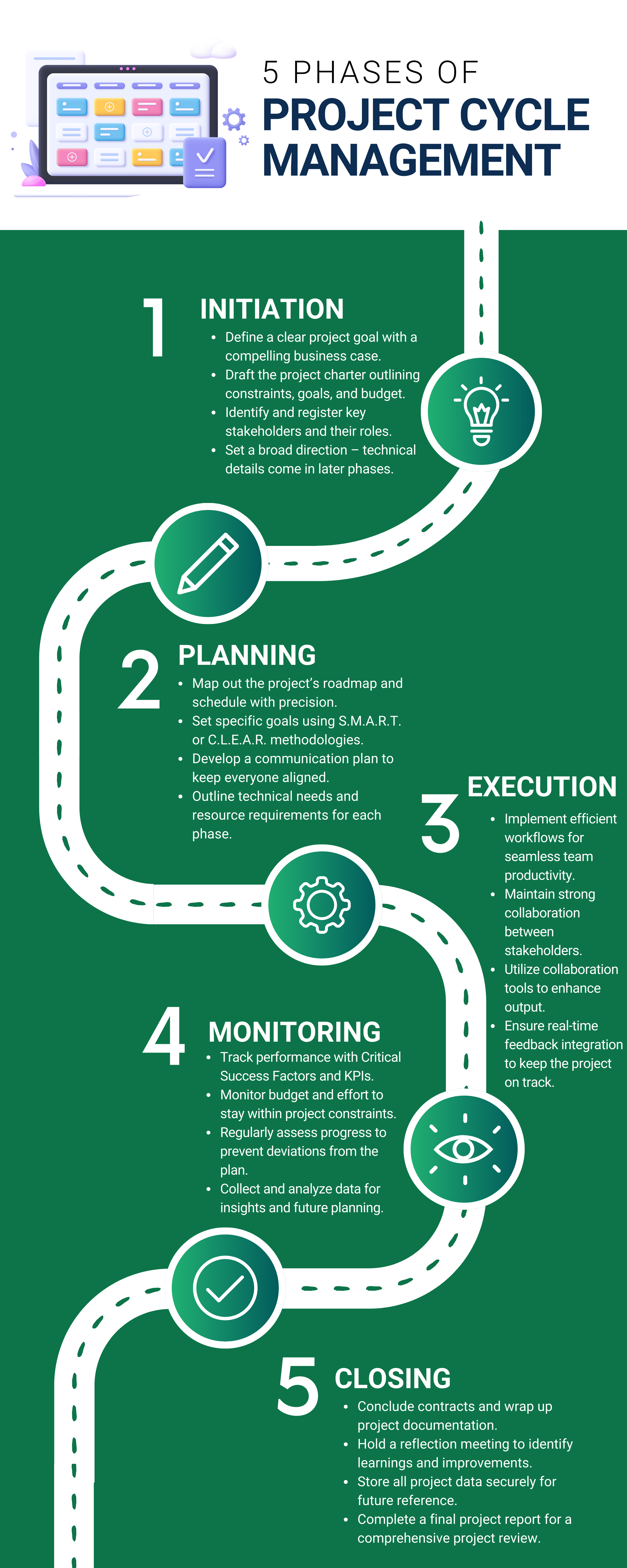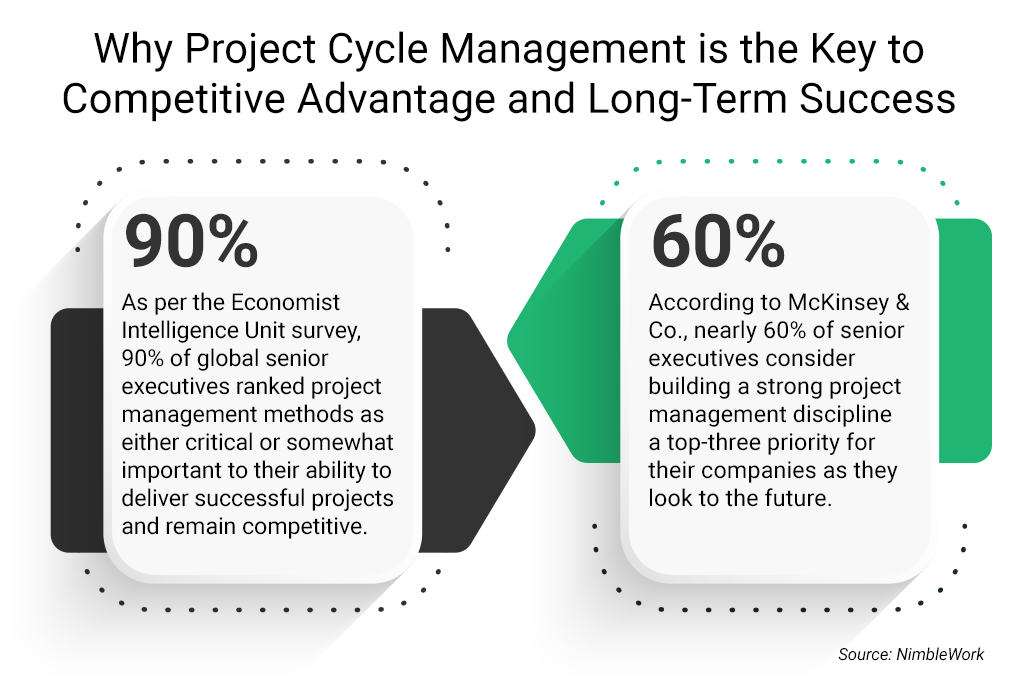
You know this scenario well as a project manager: you’re overseeing a crucial project for your company. Everything seems set—the plan is airtight, the team is skilled, and the goals are clear. Yet, halfway through, unexpected delays, budget overruns, and resource shortages start creeping in. Milestones begin to slip. This is where project cycle management comes into play.
This scenario is a reality for countless project managers who, despite rigorous planning, find themselves facing unexpected turns. The problem isn’t with the team's dedication or skill—it’s often a gap in anticipating and responding to each phase of the project with precision and adaptability.
Unlike traditional methods, project cycle management breaks each phase—from initiation and planning to execution and closure—into adaptable, manageable steps that respond to the project’s needs. Have you ever wondered how easier tracking milestones would be if each step evolved with the project? Every project phase matters, and keeping a close watch ensures that budgets and timelines stay in check.
And here’s where today’s game-changer steps in—modern technology solutions like predictive analytics. These solutions are now helping project managers foresee risks, optimize resources, and guide projects smoothly through each phase of the cycle, transforming project cycle management from a structured process into a dynamic, insight-driven journey. How would this change your approach? This article discusses the five phases of project cycle management, their importance, how they work, challenges, and best practices.
What is Project Cycle Management?
Have you ever wanted a clear roadmap to guide each project stage? The project management lifecycle offers exactly that—a structured framework from start to finish. It’s designed to give your projects structure and clarity, ensuring they stay on track and reach their goals.
Typically, this lifecycle unfolds in four key phases: initiating, planning, executing, and closing. Some also add a fifth phase, “monitoring and controlling,” between execution and closure to keep everything in check. Each phase serves a unique purpose, creating a smooth flow toward successful project completion. Mastering this process is essential for you, the project managers. It provides the structure and solutions to drive projects confidently, helping you turn plans into results.
So, how do you ensure that each milestone directly contributes to your project's long-term success?
The Phases of Project Cycle Management
 Project cycle management is a well-rounded method that allows teams to hit milestones, adapt to hurdles, and ensure timely delivery. How exactly does it work? The infographic visually represents the five essential phases of project cycle management: initiation, planning, execution, monitoring and control, and closing—illustrating the organized flow needed for effective project execution. Let’s dive into the five phases that shape every successful project journey.
Project cycle management is a well-rounded method that allows teams to hit milestones, adapt to hurdles, and ensure timely delivery. How exactly does it work? The infographic visually represents the five essential phases of project cycle management: initiation, planning, execution, monitoring and control, and closing—illustrating the organized flow needed for effective project execution. Let’s dive into the five phases that shape every successful project journey.
1. Initiation
This initial step is much like planting the seed. It’s where the initial idea takes shape, expanding into a vision with a defined scope and objectives. In this phase, project managers assess what’s essential for the project to succeed, identifying any areas needing refinement before fully diving in. It’s all about laying a solid foundation—one that helps avoid issues down the line.
2. Planning and Design
A solid plan keeps everyone on the same page and prepared for what lies ahead. In project cycle management, planning is key to minimizing risks and setting clear paths to achieve desired results. This phase is where strategies are crafted, goals are sharpened, and contingencies are considered. A strong plan can differentiate between a smooth project and one riddled with unexpected roadblocks.
3. Execution
The execution phase involves action, where team members bring the project plan to life. Every task outlined in the planning phase is now put into motion, focusing on maintaining quality and pace. This stage typically takes the longest and demands dedication and teamwork to drive the project toward its goals. With every task, the project inches closer to completion. Can everyone see the finish line?
4. Monitoring and Controlling
No project goes perfectly according to plan, so what happens if something veers off track? The monitoring and controlling phase steps are in here. This stage closely tracks progress to ensure issues are tackled promptly, adjustments are made as necessary, and timelines are met. It’s a balancing act; while too much control can stall progress, too little can open the door to unnecessary risks.
5. Closure
When the work is done, the closure phase brings everything together. This isn’t just about delivering the final product; it’s a formal wrap-up that lets managers review outcomes, gather feedback, and document learnings for future projects. Wrapping up a project correctly is essential—after all, an incomplete closeout can lead to ongoing issues and wasted resources.
Each phase brings unique value, aligning efforts toward a well-executed project. Together, they make project cycle management a comprehensive guide to getting things done right the first time. So, how do these phases drive real value and impact for teams and projects? Understanding its importance can reveal the key to achieving smoother workflows, better outcomes, and lasting project success.

Why Is Project Cycle Management Important?
Project cycle management plays a vital role in aligning projects with an organization's overall business goals, ensuring they stay relevant to the initial strategy and meet the needs of stakeholders and customers alike. By evaluating feasibility upfront, project cycle management helps prevent the waste of time and resources, focusing only on projects that can realistically deliver meaningful, sustainable benefits. This way, every project has a solid foundation before moving forward.
Project cycle management encourages active stakeholder involvement to make this process effective. Quality assessments and documentation at every stage help maintain consistency and ensure each step meets set standards. In the end, it’s all about building a project process that’s both sustainable and strategic, aligning efforts with what truly matters.
Today, artificial intelligence-driven project management solutions can support this process by organizing tasks and helping teams create custom roadmaps. They break big projects into manageable steps, encourage collaboration, and provide a clear view of progress. These modern technology solutions give teams a broader view of tasks and project priorities and offer advanced risk warnings, providing context for development and business activities. Managing a project end-to-end comes with hurdles. What are the biggest challenges, and how do you overcome them?
Challenges of Project Life Cycle Management
As a project manager, you know project cycle management isn’t a straight path; it’s more like a winding road with unexpected detours and roadblocks. But what if those challenges could be anticipated, mitigated, and effectively managed? Here’s a look at the most common hurdles in project cycle management, each demanding a specific approach to stay on track.
 Scope Creep: Project requirements that grow beyond the initial plan can strain resources and delay timelines. Establishing clear change controls and regularly reviewing project scope can help keep things on track. Additionally, utilizing predictive insights can identify patterns that indicate scope creep. It also alerts managers when additional resources or timelines are likely, helping them prevent budget blowouts before they escalate.
Scope Creep: Project requirements that grow beyond the initial plan can strain resources and delay timelines. Establishing clear change controls and regularly reviewing project scope can help keep things on track. Additionally, utilizing predictive insights can identify patterns that indicate scope creep. It also alerts managers when additional resources or timelines are likely, helping them prevent budget blowouts before they escalate.
 Resource Constraints: Limited resources can stall progress and affect outcomes. Whether reallocating resources or seeking additional support, planning ahead and building backup strategies can help.
Resource Constraints: Limited resources can stall progress and affect outcomes. Whether reallocating resources or seeking additional support, planning ahead and building backup strategies can help.
 Communication Gaps: Poor communication slows productivity and creates confusion. Establishing an open, collaborative environment and holding structured and casual meetings can keep everyone on the same page. Predictive analytics-powered project management solutions provide a centralized view of project status, milestones, and potential risks. Furthermore, it fosters stronger collaboration by giving stakeholders real-time visibility, enabling better alignment and faster, more informed decisions.
Communication Gaps: Poor communication slows productivity and creates confusion. Establishing an open, collaborative environment and holding structured and casual meetings can keep everyone on the same page. Predictive analytics-powered project management solutions provide a centralized view of project status, milestones, and potential risks. Furthermore, it fosters stronger collaboration by giving stakeholders real-time visibility, enabling better alignment and faster, more informed decisions.
So, what strategies make projects successful from start to finish?

Best Practices in Project Life Cycle Management
Project cycle management isn’t just about ticking boxes through initiation, planning, execution, monitoring, and closure. It’s about aligning each phase with a strategy that sets your project up for success, anticipating what lies ahead, and making real-time adjustments. But what does “best practice” look like in project cycle management today? Here are a few effective techniques for mastering project management:
- Set Milestones: Breaking projects into milestones with deadlines makes them feel more achievable and keeps everyone aware of progress.
- Communicate Consistently: Regular check-ins help identify bottlenecks, share ideas, and keep everyone aligned.
- Engage Stakeholders: Bringing stakeholders into the process with feedback and regular updates ensures the project meets expectations.
- Monitor Task Progress: Keeping a close watch on tasks—and making this easy for your team—helps avoid missed deadlines and ensures nothing slips through the cracks.
With the right solutions and practices, project life cycle management simplifies complex projects, helping you lead confidently. With real-time insights, proactive risk management, and smarter decision-making, projects can move from reactive to resilient.
Achieving Project Success with Confidence
Embracing project cycle management is like identifying a roadmap built for flexibility, precision, and proactive insights. Each phase brings its own techniques, empowering you to navigate challenges, adapt seamlessly, and keep your team focused on the end goal. Modern solutions, like AI-driven predictive analytics, elevate this process, turning complex projects into streamlined journeys. Are you looking for a game changer in project cycle management? TrueProject transforms how you manage projects, making every phase smoother, smarter, and more resilient.
TrueProject is a KPI-based predictive project management SaaS solution that improves project health and performance. By delivering automated project oversight and governance, TrueProject uses advanced warning, predictive intelligence, and AI to identify potential issues before they become critical, ensuring your projects stay on track and within budget. The solution provides real-time insights and predictive analytics that keep projects on track from initiation to closure. By offering visibility into potential risks and facilitating data-driven decisions, TrueProject empowers you to anticipate challenges, optimize resources, and maintain alignment with business goals.
With a structured approach, real-time insights, and predictive project management solution, you’re not just managing projects—you’re building a foundation for sustained success and growth. So, are you ready to lead your projects with newfound clarity and confidence?






